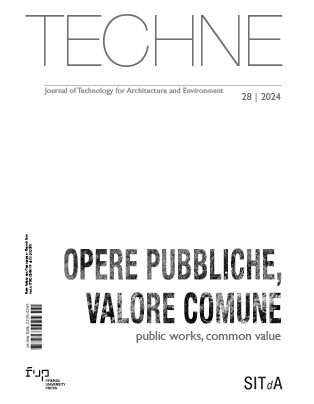Published 2024-10-29
Keywords
- Digital platforms,
- civic engagement,
- urban commons,
- e-government,
- user-centred design
How to Cite
Copyright (c) 2024 Francesca De Filippi, Cristina Coscia

This work is licensed under a Creative Commons Attribution 4.0 International License.
Abstract
The Italia Digitale 2026 Plan aims to make the country’s public administration more digitally accessible. The government has allocated 27% of the resources of its National Recovery and Resilience Plan (NRRP) for Italy’s digital transition. Considerable space is dedicated to digitisation of the public administration and the production sector: Mission 1 deals with digitisation, innovation, competitiveness and culture. The overall objective is ‘the country’s innovation in a digital key, thanks to which a real structural change can be triggered’. The contribution analyses some elements of this structural change, and highlights them through the experimentation of the MiraMap collaborative platform for the care of public spaces, within the AXTO project.
Downloads
References
- Arnstein, S. R. (2007), “A ladder of citizen participation”, Journal of the American Institute of planners, vol 35, n. 4, pp. 216-224. Available at: http://doi.org/10.1080/01944366908977225. DOI: https://doi.org/10.1080/01944366908977225
- Ciaffi, D. (2021), Rapporto Labsus 2020. Available at: https://iris.polito.it/handle/11583/2928062 (Accessed on 25/02/2024).
- Coscia, C., and De Filippi, F. (2016), “L’uso di piattaforme digitali collaborative nella prospettiva di un’amministrazione condivisa. Il progetto Miramap a Torino (ITA version)”, Territorio Italia, vol. 1, pp. 61-104. Available at: http://doi.org/10.14609/Ti_1_16_4i.
- De Filippi, F., Coscia, C., and Guido, R. (2017), “How technologies can enhance open policy making and citizen-responsive urban planning: MiraMap-a governing tool for the Mirafiori Sud District in Turin (Italy)”, International Journal of E-Planning Research (IJEPR), vol. 6, n. 1, pp. 23-42. Available at: http://doi.org/10.4018/IJEPR.2017010102. DOI: https://doi.org/10.4018/IJEPR.2017010102
- De Filippi, F., Cocina, G.G. (2022), Urban Regeneration and Community Empowerment Through ICTs, Springer International Publishing. Available at: http://doi.org/10.1007/978-3-030-17755-9.
- Falco, E., and Kleinhans, R. (2018), “Beyond technology: Identifying local government challenges for using digital platforms for citizen engagement”, International Journal of Information Management, vol. 40, pp.17-20. Available at: http://doi.org/10.1016/j.ijinfomgt.2018.01.007. DOI: https://doi.org/10.1016/j.ijinfomgt.2018.01.007
- Feeney, M. K., and Brown, A. (2017), “Are small cities online? Content, ranking, and variation of US municipal website”, Government Information Quarterly, vol. 34, n. 1, pp. 62-74. Available at: http://doi.org/10.1016/j.giq.2016.10.005. DOI: https://doi.org/10.1016/j.giq.2016.10.005
- Gulliksen, J., Göransson, B., Boivie, I., Blomkvist, S., Persson, J., and Cajander, Å. (2003), “Key principles for user-centred systems design”, Behaviour and Information Technology, vol. 22, n. 6, pp. 397-409. Available at: http://doi.org/10.1080/01449290310001624329. DOI: https://doi.org/10.1080/01449290310001624329
- Katsamakas, E., Kostapanos M., and Oleg V. P. (2022). “Digital Platforms for the Common Good: Social Innovation for Active Citizenship and ESG”, Sustainability, vol. 14, n. 2, p. 639. Available at: http://doi.org/10.3390/su14020639. DOI: https://doi.org/10.3390/su14020639
- Mattijssen, T. J.M., Buijs, A. A. E., Elands, B. H. M., Bas J.M. Arts, Van Dam, R. I., and Donders, J. L.M. (2019), “The Transformative Potential of Active Citizenship: Understanding Changes in Local Governance Practices”, Sustainability, vol. 11, n. 20, p. 5781. Available at: http://doi.org/10.3390/su11205781. DOI: https://doi.org/10.3390/su11205781
- Meijer, A., and Boon, W. (2024). “3: Digital platforms for the co-creation of public value”, in Jacob Torfing, J., Ferlie, E., Tina Jukić, T. and Ongaro, E. (Ed.) Strategic Management of the Transition to Public Sector Co-Creation. Bristol, UK: Policy Press. Available at: http://doi.org/10.51952/9781447369042.ch003. DOI: https://doi.org/10.51952/9781447369042.ch003
- Padua, D. (2017), “L’evoluzione dei modelli organizzativi nell’ecosistema digitale”, Sviluppo and Organizzazione, vol. 275, pp. 70-81. Available at: https://ricerca.unistrapg.it/handle/20.500.12071/800 (Accessed on 25/02/2024).
- Panciroli, C. (2017), “Ecosistemi digitali”, in Apprendere con i video digitali. Per una formazione online aperta a tutti. Franco Angeli, Milano, pp. 13-32. Available at: https://cris.unibo.it/handle/11585/624890 (Accessed on 25/02/2024).
- Perrucci, A. (2019), “Dai Big Data all’ecosistema digitale. Dinamiche tecnologiche e di mercato e ruolo delle politiche pubbliche”, Analisi Giuridica dell’Economia, vol. 18, n. 1, pp. 61-88. Available at: http://doi.org/10.1433/94545.
- Sarker, A. E., and Hassan, M. K. (2010), “Civic Engagement and public Accountability: an Analysis with particular reference to developing Countries”, Public Administration and Management, vol. 15, n. 2. Available at: https://www.researchgate.net/ (Accessed on 25/02/2024).
- Sturm, U. and Tscholl, M. (2019). “The role of digital user feedback in a user-centred development process in citizen science”, JCOM, vol. 18, n. 01, A03. http://doi.org/10.22323/2.18010203 DOI: https://doi.org/10.22323/2.18010203
- Thibault, M. (2016), Gamification Urbana. Letture e riscritture ludiche degli spazi cittadini. Aracne. Available at: https://iris.unito.it/handle/2318/1609721 (Accessed on 25/02/2024).
- Tricarico, L. (2019). “Innovazione sociale ai margini: contesti e strumenti per una politica regionale”. In Califano A. (Ed.) “Ecosistemi digitali: Trasformazioni sociali e rivoluzione tecnologica”, XXII ed. Colloqui internazionali di Cortona Fondazione Feltrinelli, pp. 63-80. Available at: https://iris.luiss.it/ (Accessed on 25/02/2024).
- Van Leeuwen, B. (2014), “Urban civility or urban community? A false opposition in Richard Sennett’s conception of public ethos”, European Journal of Social Theory, vol. 17, n. 1, pp. 3-23. Available at: http://doi.org/10.1177/1368431013484002. DOI: https://doi.org/10.1177/1368431013484002






